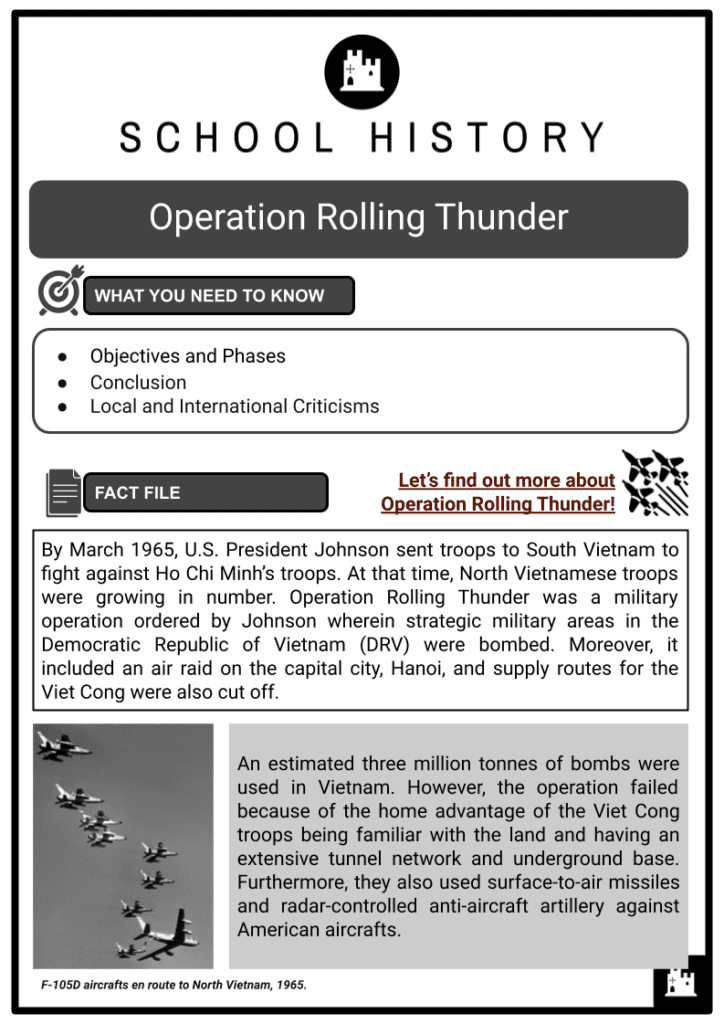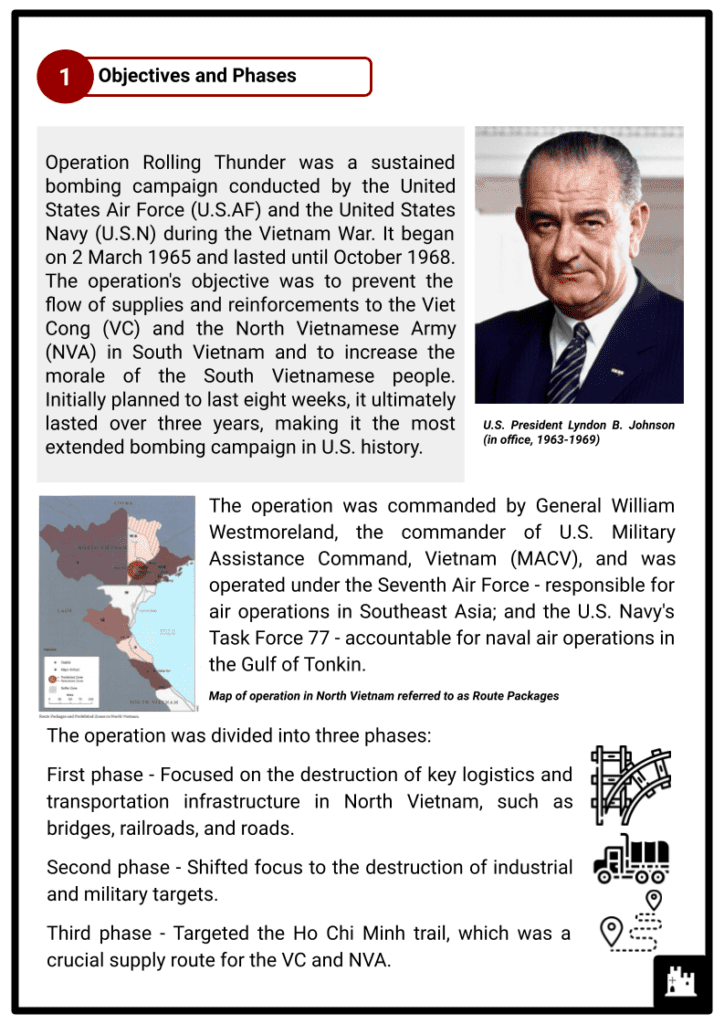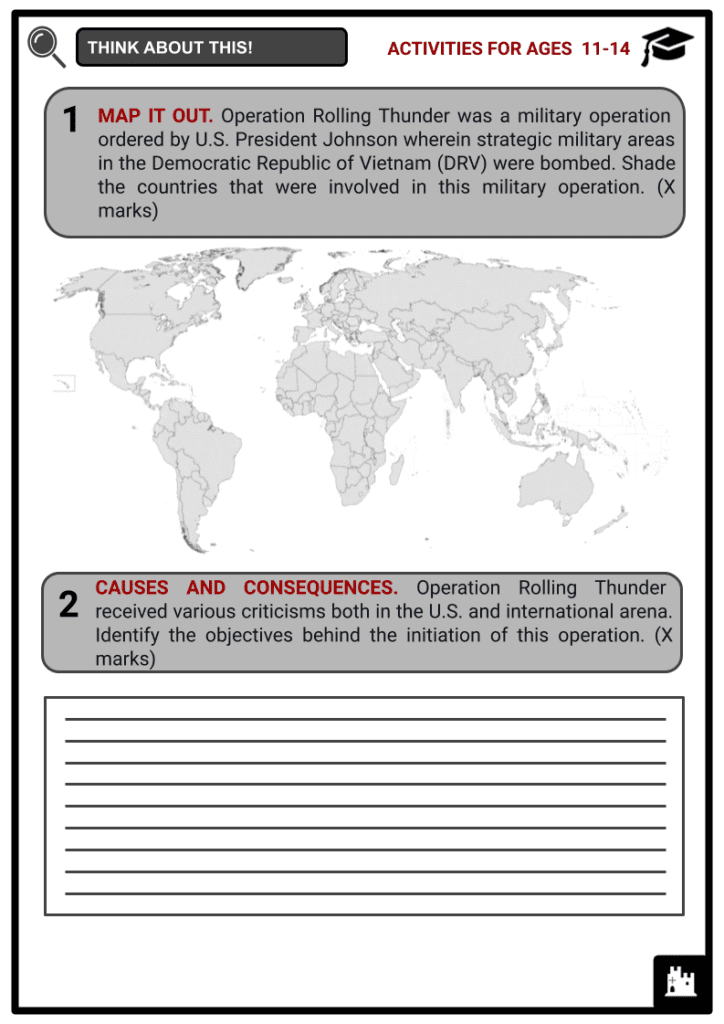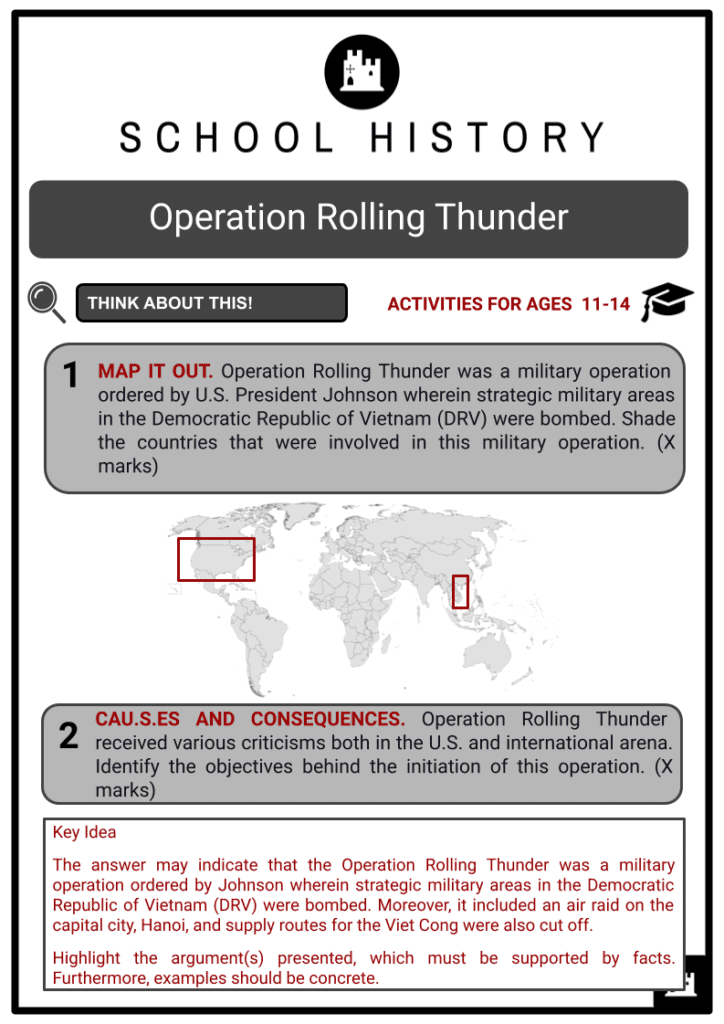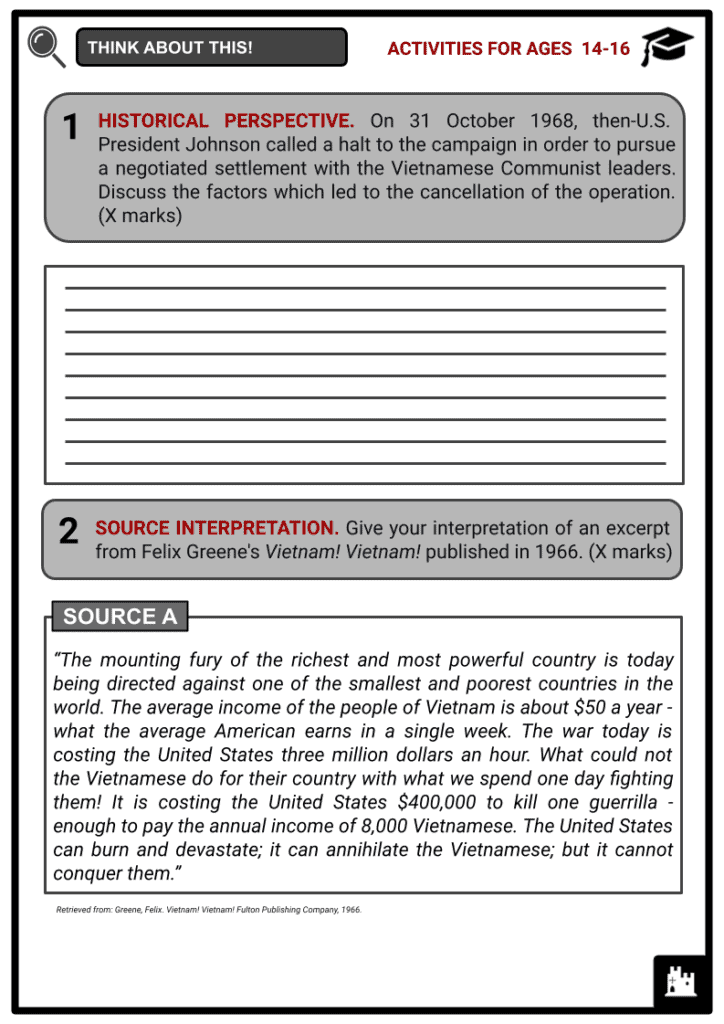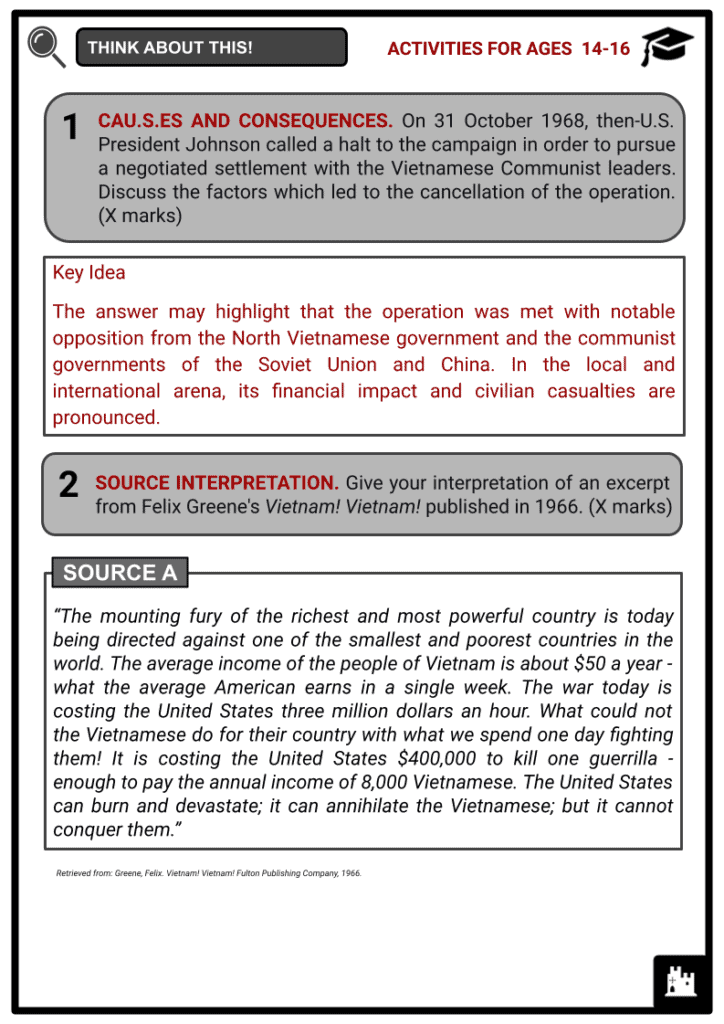Operation Rolling Thunder Worksheets
Do you want to save dozens of hours in time? Get your evenings and weekends back? Be able to teach about Operation Rolling Thunder to your students?
Our worksheet bundle includes a fact file and printable worksheets and student activities. Perfect for both the classroom and homeschooling!
Summary
- Objectives and Phases
- Conclusion
- Local and International Criticisms
Key Facts And Information
Let’s find out more about Operation Rolling Thunder!
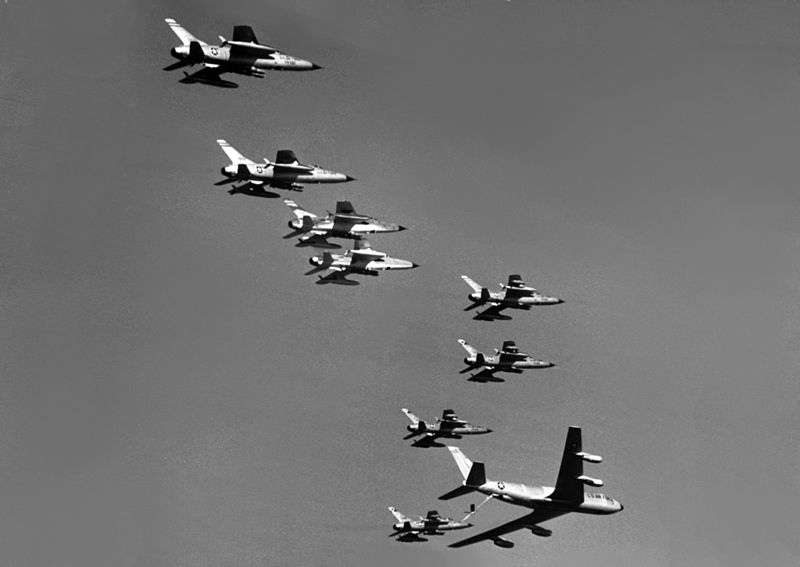
By March 1965, U.S. President Johnson sent troops to South Vietnam to fight against Ho Chi Minh’s troops. At that time, North Vietnamese troops were growing in number. Operation Rolling Thunder was a military operation ordered by Johnson wherein strategic military areas in the Democratic Republic of Vietnam (DRV) were bombed. Moreover, it included an air raid on the capital city, Hanoi, and supply routes for the Viet Cong were also cut off.
An estimated three million tonnes of bombs were used in Vietnam. However, the operation failed because of the home advantage of the Viet Cong troops being familiar with the land and having an extensive tunnel network and underground base. Furthermore, they also used surface-to-air missiles and radar-controlled anti-aircraft artillery against American aircrafts.
Objectives and Phases
- Operation Rolling Thunder was a sustained bombing campaign conducted by the United States Air Force (U.S.AF) and the United States Navy (U.S.N) during the Vietnam War. It began on 2 March 1965 and lasted until October 1968. The operation's objective was to prevent the flow of supplies and reinforcements to the Viet Cong (VC) and the North Vietnamese Army (NVA) in South Vietnam and to increase the morale of the South Vietnamese people. Initially planned to last eight weeks, it ultimately lasted over three years, making it the most extended bombing campaign in U.S. history.
- The operation was commanded by General William Westmoreland, the commander of U.S. Military Assistance Command, Vietnam (MACV), and was operated under the Seventh Air Force - responsible for air operations in Southeast Asia; and the U.S. Navy's Task Force 77 - accountable for naval air operations in the Gulf of Tonkin.

Map of operation in North Vietnam referred to as Route Packages - The operation was divided into three phases:
- First phase - Focused on the destruction of key logistics and transportation infrastructure in North Vietnam, such as bridges, railroads, and roads.
- Second phase - Shifted focus to the destruction of industrial and military targets.
- Third phase - Targeted the Ho Chi Minh trail, which was a crucial supply route for the VC and NVA.
- The operation was conducted by both the U.S.AF and the U.S.N, with the U.S.AF flying most of the bombing missions. The bombing was conducted primarily in the northern half of North Vietnam, but some bombings also occurred in the southern half and the demilitarised zone (DMZ) between North and South Vietnam. Aircrafts used in operation included the F-105 Thunderchief, the F-4 Phantom II, the B-52 Stratofortress, and the A-6 Intruder.
- Other units, such as air rescue, surveillance, and electronic warfare, also backed the operation. The overall number of personnel involved in the operation is hard to quantify but is estimated to have been tens of thousands.
Conclusion
- The operation was met with notable opposition from the North Vietnamese government and the communist governments of the Soviet Union and China. The latter two supplied material and political support to the North Vietnamese.
- By 1 November 1968, U.S. President Johnson ordered to stop the operation as part of the peace talks. It failed to achieve its main objective of destroying the North Vietnamese will to fight, as well as cutting off the supply routes of the VC and NVA. Furthermore, it caused significant destruction of North Vietnam's infrastructure and economy. It also faced criticism for causing a large number of civilian casualties and damage to civilian infrastructure.
- Casualties: By April 1967, it was estimated that there were 52,000 casualties in which, 75% of which were involved in military or quasi-military operations. In 1965, 45% of casualties were civilians and logistics workers, while in June 1967, they calculated 19,000 to 26,000 deaths, including 13,000 to 17,000 civilian deaths caused by the bombing. In general, the U.S. Central Intelligence Agency (CIA) estimated 27,900 military and 48,000 civilians were killed and wounded.
- The CIA privately estimated that damage caused by the operation totalled around 500 Million U.S.D in total.
Local and International Criticisms
- The operation faced various criticisms both in the U.S. and the international arena. The U.S. Senate Armed Services Committee even opened a hearing on 9 August 1967 regarding the operation.
- INEFFECTIVENESS The operation failed to achieve its main intent of destroying the North Vietnamese’s will to fight, as well as cutting off the supply routes of the Viet Cong (VC) and the North Vietnamese Army (NVA). Despite the heavy bombing, the North Vietnamese were able to continue to fight and maintain their supply lines.
- Furthermore, the operation was criticised for its lack of a clear strategy and for its failure to adapt to the changing situation in Vietnam. The Viet Cong troops were familiar with the land. They knew the jungles well, which meant U.S. troops often missed their targets. This was also because the Vietcong made use of an extensive tunnel network and underground bases. Hence, the operation, which was initially planned to last for eight weeks, ultimately lasted over three years.
- DIPLOMATIC PRESSURE The operation was met with significant opposition from the international arena, including the communist government of the Soviet Union and China, who furnished material and political support to the North Vietnamese.
- Furthermore, the operation also faced criticisms from the U.S. public as the bombings caused a large number of civilian casualties and damage to infrastructure. This led to a decline in public support for the war in Vietnam and for the U.S. government's way of handling the conflict. Even then, U.S. Secretary of Defense Robert S. McNamara, who supported the initial plan, later turned his disagreement with the extensiveness of the campaign. In 1966, he addressed a letter to the President of the United States describing the operations on the Ho Chi Minh Trail as a threat to the war effort.

The Ho Chi Minh Trail, 1967 - The Truong Son Road, which was originally called after a mountain range that runs across Vietnam and Laos, provided logistical assistance for communist insurgencies in South Vietnam. Later, Americans gave it the moniker, ‘Ho Chi Minh Trail’ in honour of the communist leader of Vietnam who had fiercely resisted both French colonial rule and American engagement in his nation. This road is thought to have contributed significantly to the Communist North's triumph in the Vietnam War because of its sophisticated military engineering in the 20th century.
- CIVILIAN CASUALTIES The operation resulted in significant civilian casualties and damage to civilian infrastructure, particularly in heavily populated areas such as Hanoi and Haiphong. The bombing of these areas resulted in numerous civilian deaths and injuries, as well as damage to homes, schools, and hospitals.

